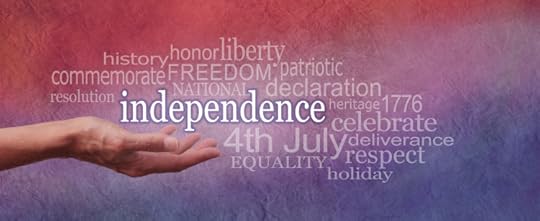Kristin Holt's Blog, page 36
July 24, 2015
Cape Disappointment: Fact and Fiction

Cape Disappointment Light
During our recent vacation to the coast of Washington State, we visited Cape Disappointment Light (the oldest operating lighthouse on the West Coast) and North Head Light. The scenery is breathtaking, the mouth of the Columbia River steeped in maritime history, and the lights, themselves, a memorable visit…especially for history buffs. The two lights are distinguishable in daylight by a black band circling the Cape Disappointment Light’s tower (North Head Light’s tower is white).
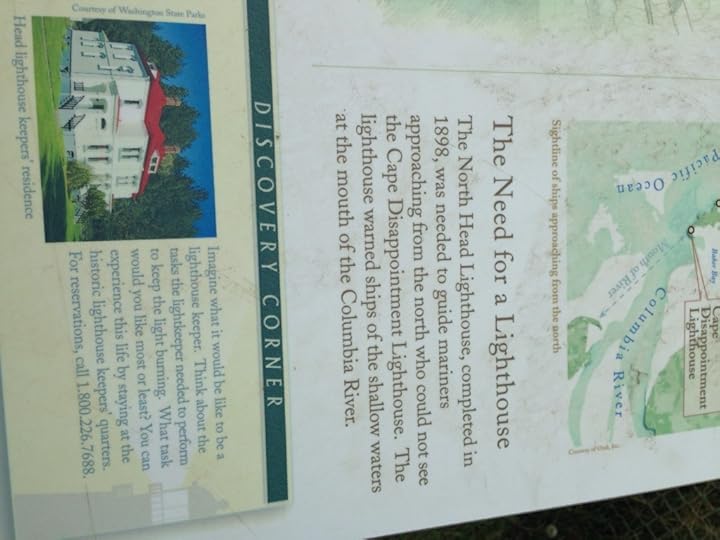 I read a western historical novel many years ago, based on the premise of an estranged couple who’d parted on very poor terms (never expected to see one another again). As the story begins, he worked as the keeper of a light somewhere, and she, in an effort to get to him, finds herself in dire straits and being the hero he is, he pulls her from the sea and saves her life.
I read a western historical novel many years ago, based on the premise of an estranged couple who’d parted on very poor terms (never expected to see one another again). As the story begins, he worked as the keeper of a light somewhere, and she, in an effort to get to him, finds herself in dire straits and being the hero he is, he pulls her from the sea and saves her life.
I can’t remember the title. Mary Burton’s The Lightkeeper’s Woman? Maybe.
I don’t think it’s The Lightkeeper by Susan Wiggs, but in my searching for the story I remembered, discovered Wiggs’s book is set precisely where (if not when) I’d visited–Cape Disappointment, Washington Territory, 1876. I do believe I’ll read this book next! While the setting is so fresh in my mind, I imagine I’ll enjoy this book even more.
With so much to learn about, contemporary and historical, both fact and fiction could keep any reader busy for a while.

North Head Light, Cape Disappointment
The two lights (I may forever refer to them as Lighthouses–one of the problems inherent in living in a landlocked state is a lack of correct terminology) are within a relatively easy hike from one another. The Coastguard Station is seated between the two lights.
Cape Disappointment National Park includes a family-friendly Lewis and Clark Interpretive Center and hiking trails. The Head Lighthouse Keeper’s Quarters are available for vacation lodging.
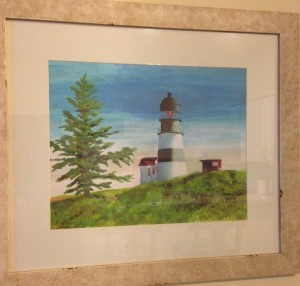 The decor of our condominium complex subtly suggested we visit the local Light. The relatively easy hikes to the two lighthouses were definitely worth the time and effort. If you’re ever on the Washington coast, make time to visit these historic sites. I wonder if Susan Wiggs paid the location a visit prior to writing her book?
The decor of our condominium complex subtly suggested we visit the local Light. The relatively easy hikes to the two lighthouses were definitely worth the time and effort. If you’re ever on the Washington coast, make time to visit these historic sites. I wonder if Susan Wiggs paid the location a visit prior to writing her book?
Copyright © 2015 Kristin Holt, LC
July 21, 2015
P.S.: Old Laundry Implements…On Vacation

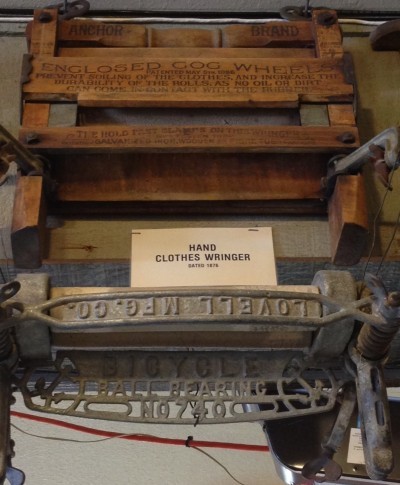

While on vacation with my family last week in Long Beach, Washington, we visited a few locations celebrating the area’s history. As fond as I am of things of bygone eras, we stopped at museums, historical sites, homes open for tours by various historical societies and the like.
During an outings, I found a clothes wringer on display, proudly proclaiming its use in 1876. The labor-saving machinery is the mostly metal item on the bottom half of the image (above), bearing (upside down) “Lovell Mfg. Co.” and “Bicycle”, “Ball Bearing” and apparently a patent number. Two wooden rollers operate with a hand crank, and the tension is managed by a metal spring, saving significant effort in ringing excessive water out of freshly rinsed clothing.
Given my two most recent posts on 19th Century Washing Machines (where I mention manglers, rollers, and more) and Warsh: Grandma’s Receet (Washing/Laundry, Granny’s Recipe), I found myself quite interested in this device. Given the setup of this curious museum (see the following paragraphs), I had to snap a picture and enlarge it, in order to read the print on the wooden contraption, above. Surely it isn’t a laundry water extraction device…but what is it?
The print on that wooden device reads: “ANCHOR BRAND, ENCLOSED COG WHEEL, Patented May 5th, 1896, Prevent soiling of the clothes, and increase the durability of the rolls as no oil or dirt can come in contact with the rubber.” On the lower ‘rung’, “The hold fast clamps on this wringer will fasten to galvanized iron, wooden, and fibre tubs.” Sure enough, I see the clamps, but have NO idea how such a contraption was used. I’m certain my great-grandmother would either A) be most disappointed in me, or B) laugh until her ‘laugher’ broke.
It took looking things up with a Google search, but sure enough, that wooden thingie is also a ‘hand-(operated) clothes wringer’.
Things have certainly changed in the process of laundering clothing.
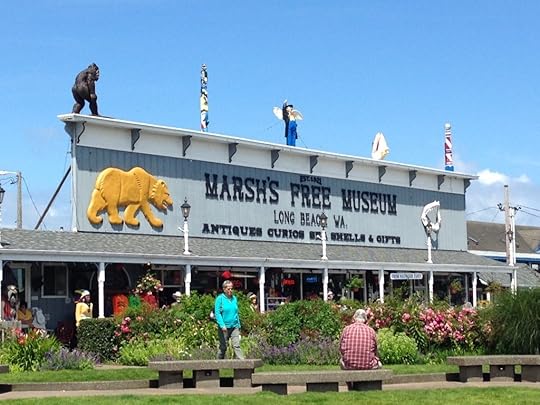
If you’re ever in the general area of this Long Beach Peninsula, stop by Marsh’s Free Museum, Established 1921 (as posted on storefront) or 1935 (as posted on their website), keep your eyes on the ceilings, rafters, and generally above-the-shelves walls, and see if you can’t spot these fabulous specimens of laundry of yesteryear.
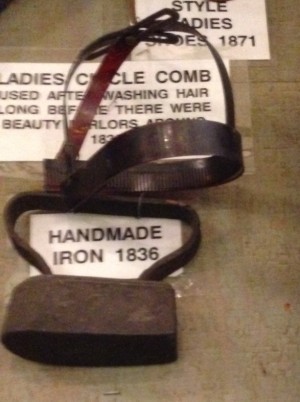 One more prize specimen spotted during this museum foray. (Ignore the Ladies’ Circle Comb.) Take a peek at the Handmade Iron, circa 1836. Someone forged that iron out of… iron… (a blacksmith?) and heated it on a wood burning stove top on ironing day. Well-to-do housekeepers had two: one to use and one to reheat. Note the lack of a heat-proof handle. The user would likely need something to protect her hand (did they have pot holders then?). I just can’t see an apron providing adequate heat protection.
One more prize specimen spotted during this museum foray. (Ignore the Ladies’ Circle Comb.) Take a peek at the Handmade Iron, circa 1836. Someone forged that iron out of… iron… (a blacksmith?) and heated it on a wood burning stove top on ironing day. Well-to-do housekeepers had two: one to use and one to reheat. Note the lack of a heat-proof handle. The user would likely need something to protect her hand (did they have pot holders then?). I just can’t see an apron providing adequate heat protection.
Related Post– Warsh: Grandma’s Receet (Washing/Laundry, Granny’s Recipe)
Related Post– 19th Century Washing Machines
Copyright © 2015 Kristin Holt, LC
July 18, 2015
19th Century Washing Machines
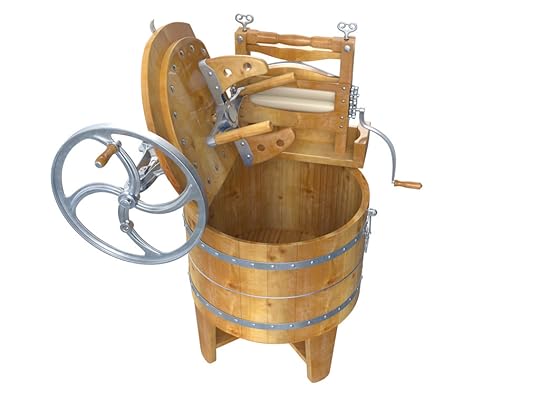
Washing clothes by hand involves lugging many buckets of water from stream, well, or barrel positioned to catch rain water, heating the water, adding soap to one tub and fresh rinse water to another tub. The long, arduous, time-consuming outdoor job of scrubbing soapy clothes over a washboard was gradually replaced by innovative hand-operated machinery that saved homemakers hours of backbreaking labor.
And to think the washboard was a new invention in 1797!
Once clothing was washed, excess water was typically removed by wringing, but the fabric still retained a great deal of rinse water. Not long after rotary machines were first invented, a roller was affixed atop the barrel for use in “mangling”, or pressing excess water out by manually cranking between the spring-tension wooden rolling pins. Each laundry item would be fed through the wringer separately. The wringer would be swung over the wash tub so that extracted wash water would fall back into the tub to be reused for the next load.
See another image of a 19th Century Metropolitan Washing Machine HERE.
American James King patented the first hand-powered washing machine to use a drum in 1851, the drum made King’s machine resemble a modern machine. The rotary washing machine was patented by Hamilton Smith in 1858.
The newly invented washing machines didn’t become generally available until the 1880s. Many women forewent the machine until the 20th century because it had a tendency to tear clothes or leave rust marks. And the washing machine was only the beginning: the clothes had to be soaked, rinsed several times, boiled, starched, blued or bleached, wrung, then hung up to dry and ironed.
“Washing,” Mrs. Julia McNair Wright wrote in her 1879 book The Complete Home: An Encyclopedia of Domestic Life & Affairs, “…is a great burden, and often a family bugbear.” “In fact, her book suggests, by strongly advising women to wash each week, that the laundry was such a burden clothes were often left dirty for weeks at a time.“
Washing machines must’ve been a scarcity and luxury in the Old West, as they’re bulky, heavy, and take up precious transportation room in a covered wagon or freight wagon. By the time the Transcontinental Railroad joined the East and West coasts of the United States in 1869, they must’ve been more available to consumers. Hand crank washing machines were first offered by the Sears, Roebuck and Co. catalog at the late date of 1896.
Is it any wonder well-to-d0 households hired housekeepers, sent clothing to a laundry, and essentially passed off this difficult task to others?
See Related Article– Warsh: Grandma’s Receet (Washing/Laundry, Granny’s Recipe)
Copyright © 2015 Kristin Holt, LC
July 15, 2015
Warsh: Grandma’s Receet (Washing/Laundry, Granny’s Recipe)
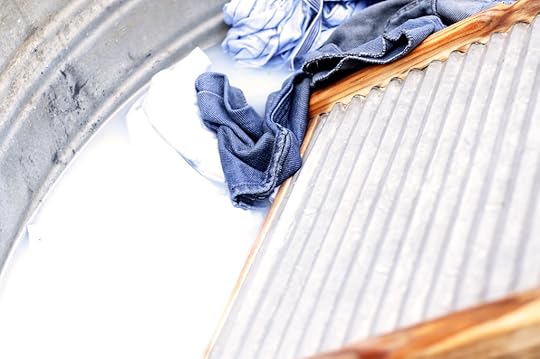

Given many years ago to a young bride by her Kentucky mountain grandmother (spelled precisely as originally written: phonetics, misspellings, misused words and all) Handed down to me from my mother-in-law about the time of our marriage (3 decades ago), as a bit of humor.
1. Bild fire in back yard to heet kettle of rain water.
2. Set tubs so smoke won’t blow in eyes if wind is pert.
3. Shave one hole cake lie soap in bilin water.
4. Sort things, make three piles, 1 pile white, 1 pile cullord, 1 pile work britches and rags.
5. Stur flour in cold water to smooth then thin down with bilin water.
6. Rub dirty spots on board, scrub hard. Then bile. Rub cullard but don’t bile.
7. Take white things out of kettle with broom handle, then rench, blew and starch.
8. Spred tee towles on grass.
9. Hand old rags on fence.
10. Pore rench water in flower bed.
11. Scrub down porch with hot soapy water.
12. Turn tubs upside down.
13. Go put on cleen dress, smooth hair with side combs, brew cup of tee–set and rest a rock a spell and count blessins.
Translations from Granny’s handwritten note to today’s standardized American English:
bilin, bile = boiling, boil
cullord, cullard = colored
rench = rinse
blew = bluing (Mrs. Stewart’s Liquid Bluing, since 1883)

Apparently, my great grandmother wasn’t the only mother who set aside any given day of the week for a certain time-consuming chore (as in wash on Mondays, iron on Tuesdays)…
Wash on Monday,
Iron on Tuesday,
Bake on Wednesday,
Brew on Thursday,
Churn on Friday,
Mend on Saturday,
Go to meeting on Sunday.
This poem (also lyrics) is traditional in the UK just as it is in the western United States (my great-grandmother). Naturally, these routine chores were in addition to everything else they had to do. Butchering, making soap, bottling the garden and fruit trees and berries, planting, pruning, feeding the animals, milking, and more.
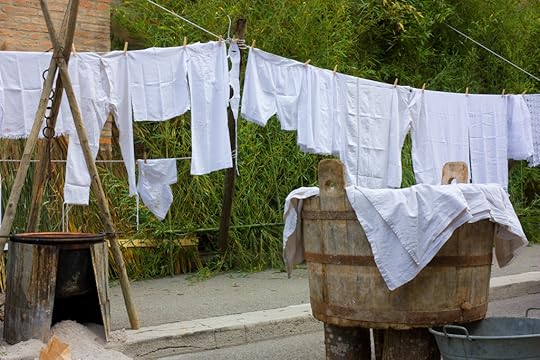
Sounds like way too much work for me. Today, I’m grateful for the ease of modern laundry. I can toss in a load whenever I have five minutes (or less), and needn’t set aside one day a week for this once-onerous chore. I may be a huge fan of historical romance, but between you and me, I’m glad I live (and do laundry) today.
The closest I’ve come to doing laundry the old-fashioned way is by writing it into a frontier-setting. I enjoyed the research (and vicarious exposure) for including a purposeful laundry day in Gideon’s Secondhand Bride, where Permilia (Millie) has a life-changing realization. After all, our thoughts wander a bit when doing mind-numbing chores.
If you’ve not read this Sweet Western Historical Romance Novella, I hope you’ll give it a try. It’s rated 4.6/5 stars with 108 ratings on Amazon.
Gideon’s Secondhand Bride is a FREE Read with kindleunlimited
Book Description
Copyright © 2015 Kristin Holt, LC
July 12, 2015
Deleted Scene (Marriage License)
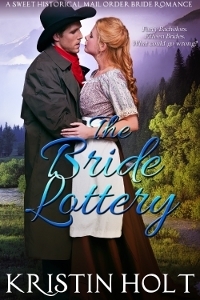 As I explained in my last post (7-10-15), during the course of writing, it’s not uncommon to remove fully completed, polished, ready-to-go scenes from a nearly finished book. When finalizing The Bride Lottery, I removed two complete scenes: the opening scene (last Friday’s post) and what I dubbed “the marriage license scene”.
As I explained in my last post (7-10-15), during the course of writing, it’s not uncommon to remove fully completed, polished, ready-to-go scenes from a nearly finished book. When finalizing The Bride Lottery, I removed two complete scenes: the opening scene (last Friday’s post) and what I dubbed “the marriage license scene”.
I wanted so much to include it, to keep it in the book, but try as I might, it didn’t do what I needed most for it to accomplish… move the story forward. So this scene ended up in a Scrivener “deleted” file, and I’ve shared it in only two places: a compilation of extras for a book club event and here, for you. It’s not in the published book, The Bride Lottery.
I loved this scene.
Still do.
Reasons why I love it include:
The miners shopping for courting gifts makes me smile
The actualization of at least one bride choosing to go home (because too many of the miners are less than her idea of a perfect companion) enriches the story
Sam’s excitement about claiming Evelyn by ensuring their marriage license is properly recorded is just too cute
***
She’d said yes.
Yes!
The glorious news had been the last thought spinning in his head when he at last fell asleep, and the first thought upon waking. When had he ever been so happy about anything?
Sam Kochler, a dirty German Immigrant orphan, was engaged to be married to the most wonderful woman in that whole passel of brides. He couldn’t believe his good fortune.
He hurried through washing, shaving, and dressing, and made his way down the stairs to the mercantile. This time of morning, dawn’s light was too weak to see by so he lit a lamp and brought out the ledger, pen, and ink.
One of the better perks of being the city clerk, elected manager of the Bride Lottery, Justice of the Peace, and storekeeper was his ability to properly file a marriage license before seven o’clock in the morning.
Something about putting pen and ink to the ledger, seeing his name alongside his bride’s added to Sam’s elation, made it more real.
He’d just finished scribing his name on the groom’s line and Mrs. Evelyn Brandt—no sense inscribing Miss and inviting further ridicule—on the bride’s line when someone pounded on the front door.
Given he wasn’t set to open for another thirty minutes, Sam thought about ignoring it. But that fist pounding didn’t sound like a man’s…it was too gentile, too soft. Had to be one of the brides. So he left the ledger and opened up.
Miss Mayme McKee stood there, her eyes reddened, her pelisse buttoned up to her chin, her bonnet tied on tight. At her feet waited two trunks and a carpetbag. How she’d managed to get those heavy trunks here at this hour, Sam couldn’t fathom, especially as he glanced both directions on the street and saw no one else about.
“Miss McKee. Good morning.”
“Is it?” A hint of sarcasm barely veiled what had to be deep hurt. “A good morning?”
Well, it had been. Until she’d knocked on his door, obviously ready to head out on the stage. He saw no other reason she’d be on his stoop with her bags packed.
“Come in, won’t you?” He ushered her inside, considered bringing her trunks in, but knew no one would bother them. He shut the door against the morning chill.
“Coffee?” he offered. “Tea?”
Miss McKee sniffed. She dabbed at her eyes with a lace-trimmed hankie she’d had clutched in her little fist. “No, thank you. I doubt I could keep it down.”
This didn’t sound like the Miss McKee he’d read about in the packet from the Agency, nor the young woman he’d watched— right along with the others— these past many days. Something had happened, and it wasn’t good.
“Will you have a seat?”
She moved to the chairs near the stove. He had yet to light a fire, but she didn’t seem to notice. And the temperature inside the mercantile was pleasant enough. She sighed heavily as she sat, forgetting to arrange her skirts all pretty-like as this particular young lady had a habit of doing. He’d seen her flirt, laugh, and arrange her skirts, what seemed like a dozen times.
All the flirt had gone out of her.
Sam itched to call out whichever of the men had done this to her. Who had offended her tender sensibilities enough that she’d decided to quit, go home, leave them? He’d have to find a way to ask such a forthright question.
“How can I help you this morning?”
She twisted her hankie. “I’m leaving on the stage. So is Miss Pritchett, but she opted to spend the day at the Quarters.”
Sam turned his gaze to the ceiling, counted to ten, tried— and barely succeeded— to rein in his frustrations. After he’d left the dance with Evelyn, something must’ve gotten out of hand. “Care to tell me what happened?”
After a long moment, Miss McKee merely shook her head.
He’d find out the truth of it, anyway. Word would scatter like falling oak leaves by noon, and he’d have the gist of it. Whether some of the fellows had gotten too friendly with their hands, had a mite too much to drink, said something a bit too crass for the sensibilities of gently bred young ladies, or worse— Sam would hear all about it. If not from the miners, then from a young lady or two.
Some were more willing to talk than others.
“If you’re not here to report the misbehavior of one of our citizens, then why are you here?”
“I can’t stay at the Quarters, not one more minute.”
That caught Sam by surprise. “Oh?”
“My roommate, Miss Quisenberry,” a dramatic sigh, “is just so… so…”
“Yes?”
“Just so… happy.” Miss McKee’s features twisted as she fought tears. “I can’t bear to hear one more word about her beloved and the wedding and how this mail order bride plan has worked out so splendidly for her, when it—” she gasped, drew breath, “failed me.”
Something about the woman’s logic left Sam clueless— why, exactly, wasn’t she holed up in her room at the Quarters, instead of here, bugging him?
“I’m sorry to hear that, ma’am.” That response seemed safest. If she’d made up her mind to leave, there wasn’t anything anybody could do. After all, the contractual agreement between the Hartford Bridal Agency and the miners of Prosperity allowed for any or all of the women to remain unmarried and leave town at their own discretion. No one was locked into anything.
But any women who left had to pay their own passage to wherever they’d decided to go.
Sam narrowed his eyes at Miss Mayme McKee, who seemed well enough off. Was that why she was here? To obtain fare for the stage and train?
“Miss McKee—”
Another knock on his front door. Obviously male this time. Sam glanced at his timepiece. Seven-thirty, on the nose. “Excuse me, ma’am. It’s time to open the store.”
Three guys waited on his doorstep, ready to part with some gold dust.
Miss McKee kept her face turned away and her attention apparently on a small book she must’ve had stashed in her reticule, taking advantage of the lamp Sam had lit.
Sam opened the roller shades, letting in what daylight streaked through the towering pines.
The three fellows set to shopping for the usual— food stuffs, a pair of denims to replace one Old Thad had worn the seat clear off and finally settled on what Sam suspected was the main purpose of their shopping excursion.
The new display of courting gifts.
Sam hid a smile as he bent over the marriage license register and finished filling in his age and freshened the pen, halting in midair over the field for bride’s age.
Oh, yes. He’d interviewed her standing in this very spot. She’d said twenty years of age.
Somehow the idea he didn’t know all that much about the particulars about his bride-to-be struck him as funny. All he knew was the woman appealed to him, made him laugh, made him want part of this bride lottery the other men had concocted… but only if she were his prize.
He signed the ledger in the space provided for the one applying for the license. There. Now all it needed was Evelyn’s full name. Did she have a middle name? Was Brandt truly her legal surname? He wanted their marriage to be legally binding.
“You can’t give a lady a fishing lure for a courting gift!” Elmer argued.
“But it’s shiny,” Tom argued. “Ladies like shiny baubles.”
“The fishing lures ain’t part of this here courting gifts display.” Elmer sighed heavily. “They’re just next to it.”
“I can give her a fishing lure if I want to.” Tom handled a tortoise shell comb, carved with ornate latticework. “This is purty.” His long fingers dwarfed the good-sized hair ornament, the girlie implement completely out of place in his hand.
“Yep. ‘Tis.” Elmer signaled Sam. “How much?”
“Two dollars.”
“Two dollars!” Tom held the comb pinched between a forefinger and thumb to set it back on the shelf. “I ain’t payin’ two dollars for a trinket like that.”
From her seat near the cold stove, Miss McKee sniffed. Evidently, the woman was doing less reading and more eavesdropping. Her judgment on the accuracy of his prices made Sam smile.
“Got anything in my price range?” Tom asked. “I’m thinking more along the lines of a quarter dollar.”
Sam chuckled. Tom’s straw-colored hair had grown like a weed and he needed a cut. He ought to visit Levi’s barber chair, ‘cause it would make the ladies receive him a lot better. “Gentlemen, you’ve got to look at courting as an investment. Ladies see the things you buy for them, the gifts you give, as a token of your affection.”
Octavia’s lectures must’ve taken, because the Southern Ladies Code of Accepting a Gentleman’s Suit came out of his mouth as if he’d intentionally memorized it.
Which he certainly hadn’t.
With this distance, he could see Octavia’s affection had been for sale— and if he could pay the price with the gifts she expected and wanted— then she’d dole out smiles and kisses and allow him to hold her hand and call on her.
He’d spent far too much of his hard-earned money on Octavia Sheline.
But now that he was in the business of collecting hard-earned gold dust from the mining community he served, the advice seemed sound enough.
“What do you know about courting gifts?” Elmer challenged. “Other than how much profit you can make?”
“He must know enough,” Old Thad responded, his tone sharp, “he got himself engaged to that pretty Mrs. Brandt last night.”
Jealousy colored Old Thad’s words and Sam nearly rocked back on his heels. Well look at that…Everyone knew the widower had determined to marry again. With dark hair shot through liberally with silver, the man wasn’t bad to look at. And he made no bones about wanting children. Evelyn came with a ready-made family and proof positive of her fertility.
Too bad she was taken.
“I heard me that. It true? She accepted you?” Awe tinged Elmer’s tone, as if he couldn’t quite believe that the likes of Sam could’ve actually won her heart.
Sam couldn’t quite believe it, either. “Yes. It’s true.”
“That’s a damn shame,” Pickle Pike uttered, loudly enough for all to hear.
Sam started. He hadn’t heard nor seen Pike enter the dimly lit mercantile. The other guys acknowledged Pickle Pike with everything from waves to bald avoidance.
The most telling of all, was Miss McKee’s stiffening spine. She held that little book up as a shield before her face, preventing Pike from seeing her features… reddened eyes, mostly, and as a sign announcing, “leave me be”.
Very telling.
“How’s it a shame?” Sam challenged. “I happen to think it’s celebratory news. Mrs. Evelyn Brandt accepted my offer of marriage.”
Pike dragged his boot heels over the freshly waxed floor, the sound as annoying as the scuffs left behind. He leaned heavily on the counter and eyed the marriage license ledger in the pool of lamplight.
Sam didn’t much care for Pike’s attitude. But the ledger was a matter of public record, so he let Pike take a gander.
“You really gonna marry that woman?”
Pike’s tone had Sam’s jaw clenching, his fists balling and itching to wipe a smirk of Pike’s face. He decided to fight cynicism with enthusiasm and happiness instead.
He plastered a big, happy grin on his face. “Yep. The pretty lady’s all mine.”
Miss Mayme McKee turned a page in her book, keeping the blockade fully erect and her defenses shored up.
The other fellows continued handling the merchandise in the Courting Gifts section, bickering over prices and the merits of each and every item.
Pike pushed the toothpick he habitually carried from the left side of his jaw to the right. His expression sparked with something a bit too much like bitterness.
Sam decided to press his point. “Soon, she’ll be Mrs. Sam Kochler to you.”
“That right.” Pike perused the ledger, tracing a blunt, grimy finger down the page and stopping where Sam and written Mrs. Evelyn Brandt. Pike tapped the entry. “You sure ‘bout this?”
Sam narrowed his gaze in warning but Pike apparently didn’t notice, or perhaps he didn’t care. Maybe he just couldn’t take a hint. Or hankered for a broken nose.
“I’m just sayin’, a man can’t be too careful. We don’t have nobody’s word but hers that she’s even a missus.”
Before Sam thought it through, he’d grabbed Pike by the dirty bandanna tied about his throat. Across the counter as they were, it was a feat to twist and lift Pike onto his toes, but the urge to defend was strong and swift. Sam’s bicep strained against his shirtsleeve as he lifted Pike a little higher. “Care to take that back?”
Pike grinned, right quick. “Nope.” He popped the ‘p.’
In Sam’s peripheral vision, it was easy to see Miss McKee had lost interest in pretending to read. Her wide eyes and softly rounded mouth gaped at his show of violence.
“Listen up, Pike, and you hear me real good.”
The fellows had fallen silent, and Sam realized he had the full attention of every last one of them, Miss Mayme McKee included. “Mrs. Brandt will soon be my wife. I won’t stand for a single murmur against her reputation. Got it?”
Pike shrugged, smirked, then shoved himself free of Sam’s grip. “Yeah, I hear you.”
Sam pinned Pike, then Tom and Old Thad with a glare that dared them to defy him.
Miss McKee slowly raised her book to cover her face once more, but not before Sam saw the saucy cock to one of her shapely brows.
“When, exactly?” Pike said, his voice malice-free for once. “Given as you’re the J.P. around here, and marrying the other couples come Saturday, I just wondered how you’re gonna get yourself married to your lady. Can’t officiate over your own nuptials.”
Sam hadn’t thought that far ahead, but no way would he admit that to this audience. “As the lady only accepted me late last night, I’m sending a letter on today’s stage to a pastor friend in Leadville, inviting him to make the trip up here. We’ll be married as soon as he can arrive.”
“Sounds expensive.” Elmer never spent a flake of gold he didn’t have to.
“I’m good for it.” He had plenty to pay the pastor’s stage fare and the man’s fee.
“You sure ‘bout this?” Pike asked, his toothpick bobbing where he held it pinched between his lips. “Your decision to find a wife seems all sudden-like. Given you was the one not wantin’ a woman to start with.”
There would be no arguing with an idiot like Pickle Pike. Sam let his happiness show in the genuine smile that spread across his face. “Boys, I’ve never been more sure about anything. It wasn’t that I didn’t want a woman,” given he’d had his heart set on Miss Octavia, “just that I didn’t know fate put Mrs. Brandt on that train, for me.”
Miss McKee apparently forgot to hide behind her book. She sighed, one hand pressed to her heart.
“Love has a way of changing a man’s plans.”
***
The Bride Lottery is a FREE Read with kindleunlimited
Another Deleted Scene: OPENING, The Bride Lottery Book Description Series Description
Copyright © 2014-2015, Kristin Holt, LC
July 9, 2015
Deleted (Opening) Scene: The Bride Lottery

Question: How do authors determine where to begin the story?
Answer: I imagine in a group of five authors, you’d obtain at least 2 different answers. How’s that for ambiguous?
Every writer has developed their own methods that work for them. We’re all different… as unique as our fingerprints. My method of ensuring my books start at the right place may be quite different from someone else’s method— and that’s perfectly OK.
My answer to this question: “As late as possible.”
This means I skip as much back story as possible— details that don’t really matter for the crux of the story yet it still makes sense. We dive right into action. It’s the latest possible moment when that ‘something’ happens and everything changes.
As I polished, finalized, evaluated The Bride Lottery in whole, I came to this conclusion with a little guidance from other authors to reinforce what I already knew. The story would be better served by cutting the opening scene (how Evelyn’s parents learn of her pregnancy). Ultimately, it didn’t matter to the story. The fact remained—they knew. And they weren’t happy. They acted. Dad sent her packing on a westbound train.
This first deleted scene comes prior to the official opening scene. It made it through nearly the final draft, when I determined to cut to the chase… Evelyn’s painful discussion with her father. This deleted scene immediately precedes it.
You may remember Allan Brandt demands of his daughter in his office, “Who is responsible for this travesty?”
The following, a deleted scene in whole, shows how her parents learned of her predicament.
***
New York City
May, 1881
Evelyn Brandt’s heart pounded with miserable anticipation and every second seemed to stretch into minutes. She smoothed the white lace coverlet on the bed where she lay. The exam had mortified her.
Doctor McKinstrey washed his hands at the basin then donned his finely tailored suit coat. He slid his gasses into the breast pocket. At last he turned his full attention on Evelyn’s parents who stood before the marble hearth.
The doctor’s refused to so much as look at her.
The roomy bedchamber seemed suddenly too close, stuffy, and airless. She wanted to kick off the covers. Or pull the sheet over her face and hide from the verdict and judgmental expressions of those gathered.
Her father, Allan Brandt, was well known for many things, but patience? Certainly not. “Well?” Worry creased his lined face.
“Your daughter—” Doc met Evelyn’s gaze, finally, his expression pungent with judgment.
Her heart sank.
No.
She’d ignored the possibility, put it out of her mind, determined to ignore the likelihood.
Not her. She was a good girl. Obedient, careful, concerned about her family’s good name.
It couldn’t be.
“—is with child.” The doctor’s tone left no room for doubt—he did not approve. He found her character lacking and her morals woefully low.
Mother gasped. Evelyn felt Mama’s acute pain like a slap.
Her stomach roiled and her dehydrated head swam with dizziness. Please, don’t let me be sick. Not again. Not now.
The constant vomiting had brought the doctor to call in the first place. Losing Mary Beth to a ruptured appendix last year had turned their parents hypersensitive to any sign of illness or infection. Mother had heard of Evelyn’s persistent vomiting and sent for the doctor.
Father’s face reddened. He clutched the head of his cane so tightly his knuckles turned white. His cleanly shaved jaw clenched and his lips thinned. She’d seen this expression before: embarrassment. Disappointing her father hurt more than the realization that she was with child.
With child. Her dehydrated body flashed hot and then cold.
Ruined. Disgraced. Society would shun her, gossip, reject her out of hand. When word got out, her fallen state would be a societal death sentence in the form of a destroyed reputation. No worthy beau would seek her company. She’d altered her entire future that fateful afternoon, and not for the better.
The weight of the news crushed the breath from her lungs. Perspiration made her white cotton nightgown stick to her clammy skin.
On the bedroom mantle, the clock ticked slowly, so slowly. She forced her breathing to conform to the seconds as they clicked past… two seconds in… two seconds out.
What would become of her?
Mother’s cool fingers clasped Evelyn’s. She noted steely determination settle over Mama’s expression. “Well, this certainly changes things.”
Father cleared his throat. “Are you certain, Doctor McKinstrey?”
“Quite.”
“No possibility otherwise?”
Evelyn’s face heated. A blush scorched its way from her chest up her throat. It seemed Father wished she were dying of an incurable malady rather than suffering a condition normal and healthy and curable—pregnancy.
To the Brandts, appearance mattered more than anything else.
“I do not need to caution you,” Father informed the doctor, “to keep this secret.”
McKinstrey clasped his hands behind his back. “Indeed not. Confidentiality is my bond.”
***
Please return on the 13th of July for another deleted scene!
The Bride Lottery is a FREE Read with kindleunlimited
Book Description
Series Description
Copyright © 2014-2015, Kristin Holt, LC
July 6, 2015
Etiquette of Conversation (19th Century U.S.A.)

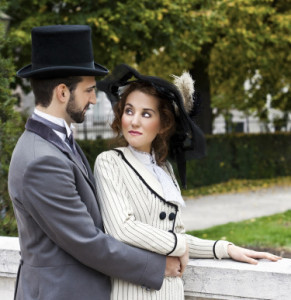

The Etiquette of Conversation.
19th Century young ladies (and gentlemen) learned a great deal about etiquette from their mothers, finishing schools, and from the societal expectations around them. The true art of conversation was a significant skill taught and expected within society, whether Philadelphia’s Old Money or the rural frontier. After all, conversation was a key element of an evening’s entertainment, courtship, and the Victorian Era’s social expectations.

“To acquire the art of conversation in a superior degree, there must be intimacy with those who possess refinement and general information. There must also be observed certain general rules in order to accomplish the best results, prominent among which are the following:
“Be cool, collected, and self-possessed, using respectful, chaste, and appropriate language.
“Recollect that the object of conversation is to entertain and amuse.
“Be patient. The foreigner cannot, perhaps, recall the word he desires; the speaker may be slow of speech; you may have heard the story a dozen times; but even then you must evince interest and listen patiently through.
“Do not always commence a conversation by an allusion to the weather.
“Do not, when narrating an incident, continually say “you see,” “you know,” etc.
“Do not use profanity, vulgar terms, slang, phrases, words of double meaning, or language that will bring the blush to any person.
“Do not intersperse your language with foreign words and high-sounding terms. It shows affectation, and will draw ridicule upon you.
“Do not make a pretense of gentility, nor parade the fact that you are a descendant of any notable family. You must pass for just what you are, and must stand on your own merits.
“Do not make a parade of being acquainted with distinguished or wealthy people, having been to college, or of having visited foreign lands. All this is no evidence of any real genuine worth on your part.
“Do not use the surname alone when speaking of your husband or wife to others. To say to another, that “I told Jones,” referring to your husband, sounds badly, whereas, to say, “I told Mr. Jones,” shows respect and good breeding.
“Do not attempt to pry into the private affairs of others by asking what their profits are, what things cost, whether Melissa ever “had a beau,” and why Amarette never got married.
“Do not aspire to be a great storyteller. an inveterate teller of long stories becomes very tiresome. To tell one or two witty, short, new stories, appropriate to the occasion, is about all that one person should inflict upon the company.” The Essential Handbook of Victorian Etiquette, Professor Thomas E. Hill (compiled from his various publications between 1873 and 1890).
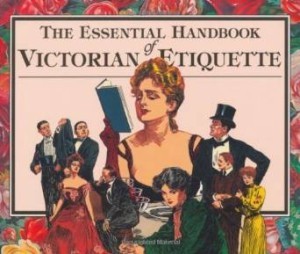

Conversation is not to talk continually, but to listen and speak in our turn.
Conversation in Western Historical Novels:
… is most enjoyable when it reflects (but doesn’t sound just like) natural conversation.
… is tricky for authors… because etiquette of the times (and locale) matter.
… conveys so much more than simple discourse; dialogue reveals character, moves the story forward, and introduces new information to the reader (and that barely scratches the surface).
… has a unique cadence, word selection, and pattern depending on the character’s gender, locale, education, and so much more.
… is often readers’ favorite segments to relish. (Do you ever find yourself skimming ahead to the next passage of dialogue?)
Related Article: Etiquette of America’s Victorian Era Love Letters
What conversation etiquette did your mother insist you use?
Copyright © 2015, Kristin Holt, LC
July 3, 2015
Happy Birthday, United States!
Only 2.5 million people lived in the United States when the colonies first declared independence, according to the U.S. Census Bureau. Today, the nation is much bigger than 13 wee states and it’s more crowded, too. This estimated population on for July 4, 2013, is 316.2 million people. [Source]
Top Ten Things You (Probably) Didn’t Know About Historical Celebrations of Independence Day:
1. Pekin, Indiana (1830) and Bristol, Rhode Island (1785) both have claims on the longest continuously running 4th of July Celebration. I’m not at all surprised other sources claim the first commemorative celebration took place many years later (1796).
2. “During the American Revolution, the legal separation of the Thirteen Colonies from Great Britain occurred on July 2, 1776, when the Second Continental Congress voted to approve a resolution of independence that had been proposed in June by Richard Henry Lee of Virginia declaring the United States independent from Great Britain.” [Source: Wikipedia]
3. “In 1777, thirteen gunshots were fired in salute, once at morning and once again as evening fell, on July 4 in Bristol, Rhode Island.” [Source: Wikipedia]
4. “Philadelphia celebrated the first anniversary in a manner a modern American would find quite familiar: an official dinner for the Continental Congress, toasts, 13-gun salutes, speeches, prayers, music, parades, troop reviews, and fireworks. Ships were decked with red, white, and blue bunting.” [Source: Wikipedia including Heintze, “The First Celebrations”]
5. On Monday, July 8, 1776, the Declaration was publicly read in Easton, Pennsylvania, and Trenton, New Jersey. Upon hearing of the Declaration, church bells rang all day in Philadelphia.
6. The Nation’s first fireworks on the Fourth of July were authorized by Congress for July 4, 1777, in Philadelphia, to celebrate the one year anniversary of the signing of the Declaration of Independence.
7. In 1778, from his headquarters at Ross Hall, near New Brunswick, New Jersey, General George Washington marked July 4 with a double ration of rum for his soldiers and an artillery salute (feu de joie) [Source: Wikipedia].
8. In 1779, The Fourth falls for the first time on a Sunday and celebrations take place on the following day, initiating that tradition.
10. Independence Rock (Wyoming) is so named for a fur trader’s celebration held there in 1830. Emigrants along the Oregon Trail were on time in their journey if they reached this sizable landmark by July 4th. More than 5,000 emigrant names are carved into this “Great Register of the Desert”. See a modern map pinpointing Independence Rock here.
Thus may the 4th of July, that glorious and ever memorable day, be celebrated through America, by the sons of freedom, from age to age till time shall be no more. Amen, and amen (Virginia Gazette, 18 July 1777).
Other less-known historical facts:
“Both John Adams and Thomas Jefferson, the only signers of the Declaration of Independence later to serve as Presidents of the United States, died on the same day: July 4, 1826, which was the 50th anniversary of the Declaration.” [Source: Wikipedia]
“The act of Congress establishing Fourth of July as a holiday, but without pay, for federal employees and the District of Columbia occurred in 1870.” [Researcher James R. Heintze]
“On June 29, 1938, by joint resolution of Congress, the Fourth of July was legislated as a Federal holiday with pay for its employees.” [Researcher James R. Heintze]
Note: James R. Heintze has compiled a wealth of information about the history of Independence Day since (at least) 1776. Interested? Find a database here.
Copyright © 2015 Kristin Holt, LC
June 30, 2015
America’s Victorian Era Love Letters
Fans of Mail Order Bride (sometimes abbreviated as MOB) historical romances know that many of these marriages of convenience involved letter-writing for a couple to become acquainted and perhaps eventually marry. Men and women would exchange tender sentiments, sometimes written in artful and poetic language to express feelings of the heart, sometimes bold and direct.
The curious thing is that writing and love letters between a courting couple wasn’t a phenomenon for those separated by distance. Connected couples in the Victorian Era United States often sent love letters to one another as part of their courtship, even when the other party resided nearby.
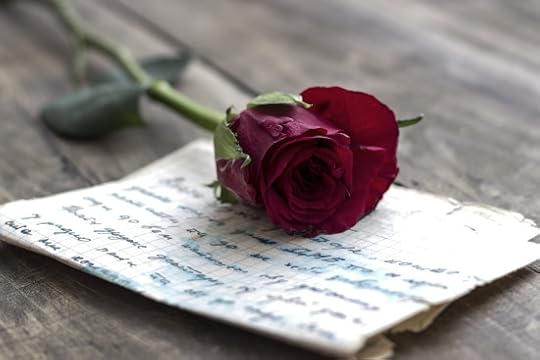
Etiquette of the era governed acceptable use of love letters and correspondence.

TOP TEN THINGS YOU (PROBABLY) DON’T KNOW ABOUT AMERICAN VICTORIAN LOVE LETTERS:
1. In a time when all correspondence was written by hand, love letters were given the utmost attention and prepared most carefully. After all, they’re the most read, re-read, and will be cherished (hopefully) for a lifetime.
2. Love letters were written with great care for perfection. Spelling, grammar, sentence structure, turn of phrase, and determination to retain dignity were all of concern. Young ladies were cautioned by parents (and specialists in social etiquette) to exercise restraint in writing of all letters to suitors; feelings change with time, her love may be unrequited, and no highborn young lady would expose herself to potential ridicule by a careless man.
3. If the courting couple mutually determined to end their romance, both parties would return all love letters and other mementos of affection. It was deemed very poor conduct to retain love letters after the demise of a relationship, speak of the contents with anyone else, or allow others to read them.
4. In most cases, correspondence was appropriately conducted only with the assent and approval of the young lady’s parents and the young man’s parents.
5. For a young lady to make light of sentiments expressed by a beau in a letter was considered most unseemly.
6. No gentleman (emphasis on gentleman) would think of boasting of love conquests amongst his peers. It was deemed most inappropriate to disclose to his chums any details of correspondence between himself and a young lady.
7. Gentlemen were allowed to contact a young lady, to whom he’d had no formal introduction, by letter, to request permission to call on her. First, he had to find one who knew her name and address. Such letters generally spoke of the circumstances and location where he’d glimpsed her, why he wanted to call on her (visit her at home), and who in town could speak for him. This was considered most risky, for the young lady could just as easily express disinterest in a return note as welcome his interest.
8. When circumstances did not allow an enamored young man to determine the identity of a young woman he’d seen on the street and had a grand first impression, it wasn’t uncommon to post a personal advertisement in the papers. Culturally, this happened with great frequency in the United States. Young ladies were cautioned to exercise extreme caution, to never disclose her name or address until she’d received a reply (addressed to the newspaper office) revealing his motivation for contacting her and provided character references. Often these unconventional introductions began a beautiful correspondence and courtship… but just as often, young ladies became a laughingstock among young men (note the absence of gentlemen) posting notices for sport.
9. Etiquette allowed for either a young lady or gentleman to terminate a courtship (and correspondence) in writing. Such letters would often speak frankly, expressing regret along with precise reasons why they had determined pursuing the possibility of further romance a poor idea.
10. It was not uncommon, nor was it considered poor manners, for a nervous young gentleman to propose marriage in writing. Often these proposals would request a return note within the hour, including a parting phrase something like, “I anxiously await your reply”. If in the presence of his beloved, young men also had the freedom to pass her a note wherein he’d written his question.

My selection of Top Ten Things You (Probably) Don’t Know About American Victorian Love Letters was gleaned from reading The Essential handbook of Victorian Etiquette, (1994, Bluewood Books) an adaptation by American Professor Thomas E. Hill between 1878 and 1890 (ISBN: 0912517123). 
Recommendation: Love Letter Collection (A Timeless Romance Anthology Book 6). This anthology contains six sweet novellas (3 historical and 3 contemporary), all with the theme of love letters.
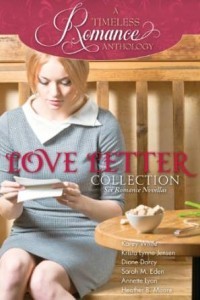
Do you have access to historic love letters written by ancestors? If so, how does this glimpse of their personalities or courtship affect your connection to them?
OR…
Have you read a favorite historical romance that included an element of love letters? What did you enjoy most about it?
Copyright © 2015 Kristin Holt, LC
June 27, 2015
Old Time Recipe: Shortbread
Shortbread Cookies/Biscuits and Butter Cookies
Traditional Recipes from our European Immigrant Ancestors
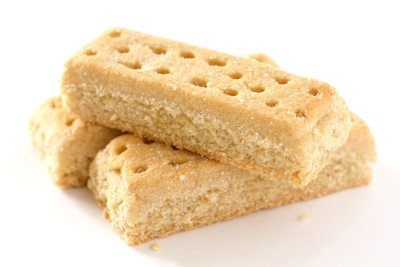
Classic Shortbread Finger Biscuits
Shortbread is a most traditional cookie (biscuit, if you’re from the U.K.) enjoyed by our immigrant ancestors. Similar to Butter Cookies in Scandinavia, this delicious, simple cookie is common in most of our great-grandmothers (and great-great-great grandmother’s) repertoire.
For example, this simple shortbread cookie recipe’s quantities (almost) follow the 1:2:3 rule:
INGREDIENTS
1/2 cup granulated sugar
1 cup butter, softened
2 cups flour
(OK. It’s not quite 1:2:3, but close)
INSTRUCTIONS
Cream butter and sugar until light and fluffy; gradually stir in flour until well blended. Spread or pat in an ungreased 13x9x2-inch baking pan. Bake at 300° for 30 to 40 minutes, until just lightly browned. Remove from oven and immediately pierce all over with a fork. Cut into bars. Cool completely before removing from pan. Makes about 3 dozen cookies.
The simple ingredients are combined until well blended, shaped (typically into individual cookie rounds or into “fingers”, 3/4-inch thick and rectangular [as with the recipe provided, above], or baked into one round and cut upon removal from oven). Part of the preparation process is to prick dough with with tines of a fork. Recipes I’ve seen haven’t given the reason for pricking dough, but as a baker, I assume it’s so air bubbles aren’t trapped inside the hot cookie, disrupting the uniform thickness.
Note the absence of eggs, baking powder, and baking soda. Without leavening agents, the cookie doesn’t spread or rise and maintains the precise shape the pastry chef desires. They’re baked in a cool oven (low temperature) with the objective of not turning them golden brown. Perfect shortbread is pale, crisp, a little bit flaky and tender, and frankly–delicious.
“Shortbread is generally associated with and originated in Scotland. Due to its popularity it is also made in the remainder of the United Kingdom, and similar biscuits are also made in Denmark, Ireland and Sweden. The Scottish version is the best-known, and Walkers Shortbread is Scotland’s largest food exporter.” [Source: Wikipedia]
Here’s one of those similar biscuit (a.k.a. cookies, in America) recipes attributed to Denmark.
PEBBER NODDER (Danish Christmas Cookies)
“These cookies are like little bites of Christmas. Cinnamon and cardamom flavor these little shortbread nuggets.”
INGREDIENTS
1 cup butter
1 cup sugar
2 eggs
2 1/2 cups all-purpose flour
1 teaspoon ground cardamom
1 teaspoon ground cinnamon, or to taste
INSTRUCTIONS
Preheat the oven to 350 degrees F (175 degrees C).
In a large bowl, mix together the butter and sugar until smooth. Beat in the eggs one at a time, stirring until light and fluffy. Combine the flour, cardamom and cinnamon; stir into the sugar mixture just until blended.
Separate the dough into 6 balls, and roll each ball into a rope about as big around as your finger on a lightly floured surface. Cut into 1/2-inch pieces, and place them on an ungreased baking sheet.
Bake for 10 minutes in the preheated oven, or until lightly browned. Cool on baking sheets for a few minutes, then transfer to wire racks to cool completely.
Note: Notice this particular shortbread cookie recipe does include eggs, but no baking powder, baking soda, or salt.

Question: Why does an author of historical fiction care about cookie recipes–even old fashioned ones?
Answer: Top 5 Reasons Why I care about Old Fashioned Cookie Recipes–
Authenticity, including baking practices and recipes handed down from generation to generation.
Accuracy. The more I know about the time period, the better. I can’t have baking powder on my character’s shopping list if no one used baking powder on the Kansas frontier in 1870.
Fictional Characters have to eat, too. Might as well ensure they’re eating types of foods available in the American West. Mention of food or meals might be brief or might be significant… but whatever makes it into the final draft must be a true reflection of history.
Too many of our traditional ways have been lost to industrialization and scientific advancements (such as very few people make their own soap anymore). I enjoy learning about how things used to be… even if I don’t do things that way anymore.
I love cookies. Shortbread and my Danish great-grandmother’s Butter Cookies top the list of personal faves.
Please forward this post or share the link with friends who enjoy baking, collect family history or old-time recipes, or enjoy historical fiction.
Copyright © 2015 Kristin Holt, LC
Kristin Holt's Blog
- Kristin Holt's profile
- 117 followers


